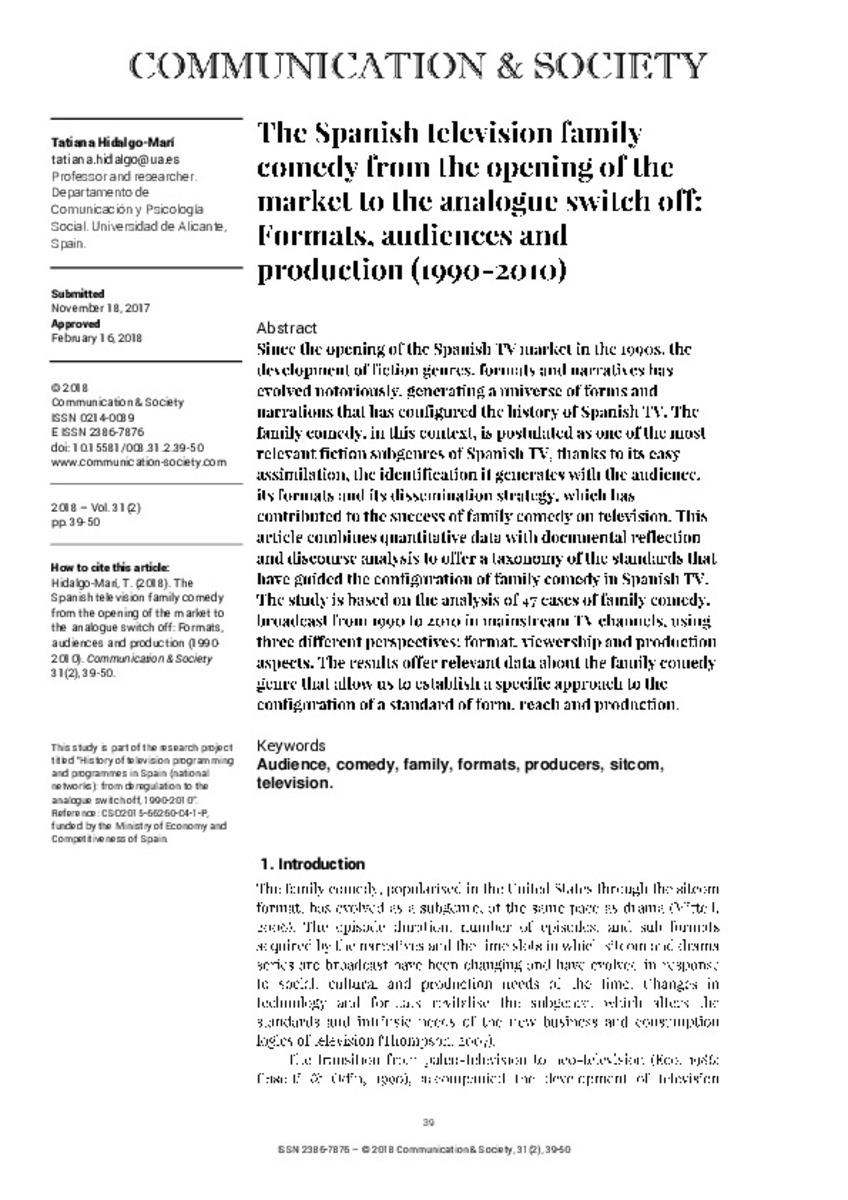Full metadata record
| DC Field | Value | Language |
|---|---|---|
| dc.creator | Hidalgo-Marí, T. (Tatiana) | - |
| dc.date.accessioned | 2018-11-09T09:08:07Z | - |
| dc.date.available | 2018-11-09T09:08:07Z | - |
| dc.date.issued | 2018 | - |
| dc.identifier.citation | Hidalgo-Marí, T. (Tatiana). "The Spanish television family comedy from the opening of the market to the analogue switch off: Formats, audiences and production (1990-2010)". Communication & Society. 31 (2), 2018, 39 - 50 | es |
| dc.identifier.uri | https://hdl.handle.net/10171/55709 | - |
| dc.description.abstract | Since the opening of the Spanish TV market in the 1990s, the development of fiction genres, formats and narratives has evolved notoriously, generating a universe of forms and narrations that has configured the history of Spanish TV. The family comedy, in this context, is postulated as one of the most relevant fiction subgenres of Spanish TV, thanks to its easy assimilation, the identification it generates with the audience, its formats and its dissemination strategy, which has contributed to the success of family comedy on television. This article combines quantitative data with documental reflection and discourse analysis to offer a taxonomy of the standards that have guided the configuration of family comedy in Spanish TV. The study is based on the analysis of 47 cases of family comedy, broadcast from 1990 to 2010 in mainstream TV channels, using three different perspectives: format, viewership and production aspects. The results offer relevant data about the family comedy genre that allow us to establish a specific approach to the configuration of a standard of form, reach and production. | es_ES |
| dc.description.abstract | Desde que se produjo la apertura televisiva en los años noventa en España, el desarrollo de géneros, formatos y narrativas alrededor de la producción de ficción ha evolucionado de forma notoria, dando lugar a todo un escenario de formas y narraciones mediante las que se ha configurado la propia historia de la televisión española. La comedia familiar, en este contexto, se postula como uno de los subgéneros más relevantes de la ficción televisiva española gracias a su fácil asimilación, la similitud que genera con las audiencias y la propia estrategia derivada de los formatos y estrategias en su difusión, que ha contribuido al éxito televisivo de las comedias familiares. El presente trabajo, mediante una metodología mixta que combina datos cuantitativos con la reflexión documental y el análisis del discurso narrativo, pretende ofrecer una taxonomía sobre el estándar alrededor del cual se ha configurado la comedia familiar en España. Para ello analiza 47 ejemplos categorizados como comedias familiares, emitidas desde 1990 hasta 2010 en cadenas generalistas, desde tres perspectivas distintas: el formato, los índices e impactos en términos de audiencias y la labor de las productoras. Los resultados ofrecen datos relevantes alrededor de la comedia familiar que permiten establecer una aproximación específica a la configuración de un estándar de forma, alcance y producción. | es_ES |
| dc.language.iso | eng | es_ES |
| dc.rights | info:eu-repo/semantics/openAccess | es_ES |
| dc.subject | Audience | es_ES |
| dc.subject | Comedy | es_ES |
| dc.subject | Family | es_ES |
| dc.subject | Formats | es_ES |
| dc.subject | Producers | es_ES |
| dc.subject | Sitcom | es_ES |
| dc.subject | Television | es_ES |
| dc.title | The Spanish television family comedy from the opening of the market to the analogue switch off: Formats, audiences and production (1990-2010) | es_ES |
| dc.title.alternative | La comedia familiar española desde la apertura del mercado televisivo hasta el apagón analógico: Formatos, audiencias y producción (1990-2010) | es_ES |
| dc.type | info:eu-repo/semantics/article | es_ES |
| dc.publisher.place | Pamplona | es_ES |
| dc.identifier.doi | 10.15581/003.31.35713 | es_ES |
| dadun.citation.endingPage | 50 | es_ES |
| dadun.citation.number | 2 | es_ES |
| dadun.citation.publicationName | Communication & Society | es_ES |
| dadun.citation.startingPage | 39 | es_ES |
| dadun.citation.volume | 31 | es_ES |
Files in This Item:
Statistics and impact
Items in Dadun are protected by copyright, with all rights reserved, unless otherwise indicated.






